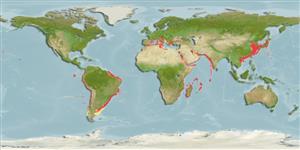Gymnolaemata |
Cheilostomatida |
Bugulidae
Environment: milieu / climate zone / djupintervall / distribution range
Ekologi
; djupintervall 0 - 320 m (Ref. 865). Temperate
Circumglobal in tropical and temperate seas.
Length at first maturity / Size / Weight / Age
Könsmognad: Lm ? range ? - ? cm Max length : 10.0 cm H hane/ej könsbestämd; (Ref. 3248)
Maximum depth from Ref. 116066. Epibenthic, encrusting, erect (Ref. 116066). Found in rocky subtidal (Ref. 116251), on giant kelp fronds, pilings, and boats hulls to a depth of 80 meters (Ref. 865). Suspension feeder (Ref. 116251). Part of fouling communities attached to raft frames in mariculture zones (Ref. 127121).
Life cycle and mating behavior
Könsmognad | Reproduktion | Lek | Eggs | Fecundity | Larvae
Members of the phylum Bryozoa are hermaphroditic. Both fertilization and egg brooding may either be internal or external.
Gappa, J.L. 2000 Species richness of marine Bryozoa in the continental shelf and slope off Argentina (south-west Atlantic). Diversity and Distribution. 6:15-27. (Ref. 1202)
IUCN Red List Status
(Ref. 130435: Version 2025-1)
CITES status (Ref. 108899)
Not Evaluated
Not Evaluated
Threat to humans
Human uses
| FishSource |
Verktyg
Ytterligare information
Population dynamicsTillväxtMax. ages / sizesLength-weight rel.Length-length rel.Length-frequenciesMass conversionAbundans PhysiologySyreförbrukning
Human RelatedStamps, coins, misc.
Internet-källor
Estimates based on models
Preferred temperature
(Ref.
115969): 14.8 - 24.9, mean 19.7 (based on 400 cells).
Fishing Vulnerability
Low vulnerability (10 of 100).
Price category
Unknown.
